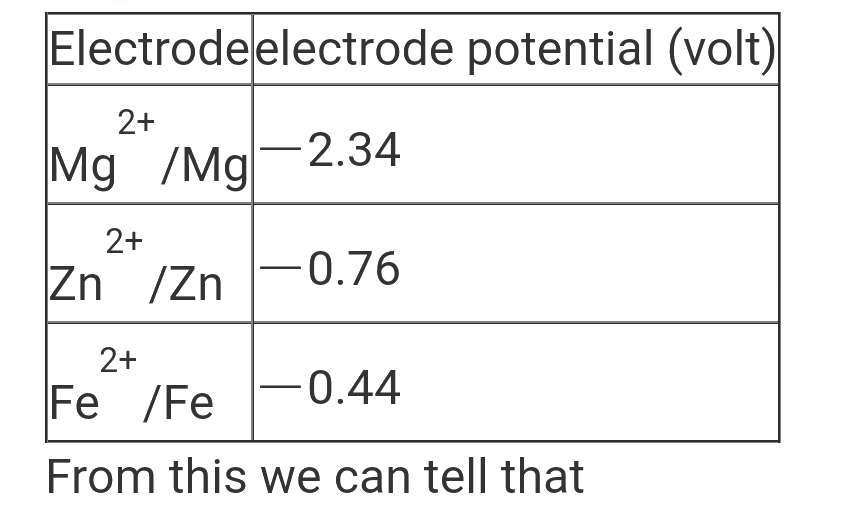Standard reduction potential (SRP) of fluorine is highest. Comment
To comment on why the standard reduction potential (SRP) of fluorine is the highest, we can break down the explanation into several key points:
1. Understanding Standard Reduction Potential (SRP):
- The standard reduction potential is a measure of the tendency of a chemical species to acquire electrons and thereby be reduced. A higher SRP indicates a stronger oxidizing agent.
2. Fluorine Reduction Reaction:
- The reduction half-reaction for fluorine can be represented as:
F2+2e−→2F−
- The standard reduction potential for this reaction is +2.87 volts, which is the highest among all elements.
3. Ease of Anion Formation:
- Fluorine is the most electronegative element, which means it has a strong tendency to attract electrons. This makes it very easy for fluorine to form anions (F⁻) from its elemental form (F₂).
4. Hydration Enthalpy:
- The hydration enthalpy of fluoride ions (F⁻) is very high. This means that when fluoride ions are formed, they are stabilized significantly by interactions with water molecules. The high hydration enthalpy contributes to the overall stability of the fluoride ion.
5. Low Bond Dissociation Energy:
- Fluorine has a low bond dissociation energy for the F-F bond. This means that it requires less energy to break the bond in F₂, facilitating the formation of fluoride ions.
6. Small Ionic Size:
- The small size of the fluoride ion allows for strong interactions with water molecules, leading to a high hydration enthalpy. This small ionic radius also contributes to the high electronegativity of fluorine.
7. Conclusion:
- Due to these factors—ease of anion formation, high hydration enthalpy, low bond dissociation energy, and small ionic size—fluorine has the highest standard reduction potential, making it the strongest oxidizing agent.
Final Comment:
Fluorine's high standard reduction potential (+2.87 V) is attributed to its strong tendency to gain electrons, high hydration enthalpy, and low bond dissociation energy, making it the best oxidizing agent.
- The standard reduction potential is a measure of the tendency of a chemical species to acquire electrons and thereby be reduced. A higher SRP indicates a stronger oxidizing agent.
- The reduction half-reaction for fluorine can be represented as:
F2+2e−→2F−
- The standard reduction potential for this reaction is +2.87 volts, which is the highest among all elements.
- Fluorine is the most electronegative element, which means it has a strong tendency to attract electrons. This makes it very easy for fluorine to form anions (F⁻) from its elemental form (F₂).
- The hydration enthalpy of fluoride ions (F⁻) is very high. This means that when fluoride ions are formed, they are stabilized significantly by interactions with water molecules. The high hydration enthalpy contributes to the overall stability of the fluoride ion.
- Fluorine has a low bond dissociation energy for the F-F bond. This means that it requires less energy to break the bond in F₂, facilitating the formation of fluoride ions.
- The small size of the fluoride ion allows for strong interactions with water molecules, leading to a high hydration enthalpy. This small ionic radius also contributes to the high electronegativity of fluorine.
- Due to these factors—ease of anion formation, high hydration enthalpy, low bond dissociation energy, and small ionic size—fluorine has the highest standard reduction potential, making it the strongest oxidizing agent.
Fluorine's high standard reduction potential (+2.87 V) is attributed to its strong tendency to gain electrons, high hydration enthalpy, and low bond dissociation energy, making it the best oxidizing agent.
Similar Questions
A : Fluorine acts as a stronger oxidising agent than chlorine.
R : Standard reduction potential of fluorine is higher than Cl2
View SolutionStandard reduction potential is calculated at
View SolutionStandard reduction potential of most of the transition elements is generally
View SolutionSTATEMENT-1: If SOP of substance is less than -1.23 V and over voltage=0V, then its oxidation in its aqueous solution is not possible at 298 K. ,
STATEMENT-2: Standard reduction potential (SRP) of water is +1.23V.
View SolutionIonisation potential of fluorine is abnormally high. It is due to
View Solution
consider the standard reduction potentials (in volts) as shown in figure Find E∘
View SolutionA certain electrode has standard ( reduction potential ) of 0.384V. The potential when measured against a normal calomel electrode ( with electrode potential=0.28V) is
View SolutionWhat is the EMF of a galvanic cell if the standard reduction potential of the reduction half-reaction is -0.38 volts and the standard reduction potential of the oxidation half-reaction is 0.52 volts?
View SolutionIn the Zn - Cu cell, standard reduction potential of Zn=-0.763 volt. Standard reduction potential of Cu=0.335 volt. Name the cathode and anode in this electrochemical cell.
View SolutionThe standard reduction potential at 298 K for single electrodes are given below.l

From this we can tell that
View Solution